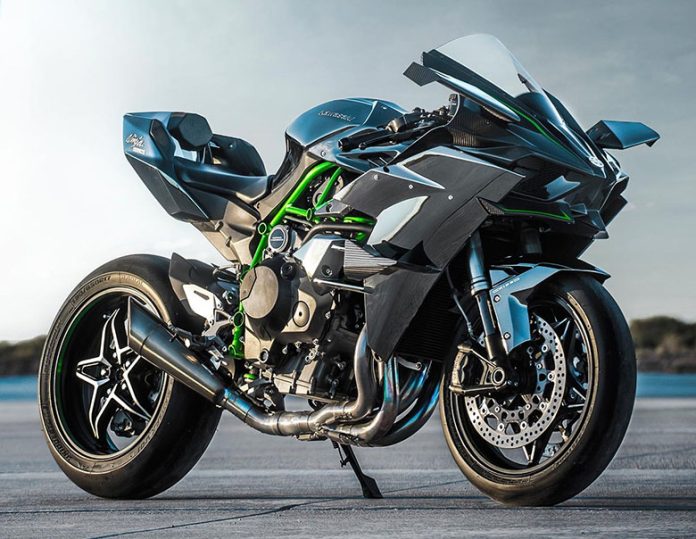The supercharged 2023 Kawasaki Ninja H2R Sports Motorcycle, Kawasaki Ninja H2, and Kawasaki Ninja H2 Carbon models from Kawasaki’s 2023 hypersport motorcycle lineup are better than ever. The development of the Ninja H2R is ahead of any other Kawasaki motorbike. The world’s only limited-edition supercharged hypersport model, “Built Beyond Belief,” is the unbridled pinnacle of Kawasaki engineering, with mind-boggling acceleration and astonishing acceleration fit only for the racetrack making it one of the Fastest Motorcycle in the World.
A high-performance racing suspension that is fully adjustable, a robust single-sided swingarm, a lightweight trail frame, carbon fiber aerodynamic devices, a 998cc inline four-cylinder engine, and compact superbike dimensions all feature on the Ninja H2R.
With Brembo Stylema monobloc brakes, Ohlins rear shock, Kawasaki Launch Control Mode (KLCM), highly flexible self-healing paint, and the latest electronics and technological advancements, this motorbike is specially designed for closed courses. The 2023 Kawasaki Ninja H2R Sports Motorcycle is available in Mirror Coated Matte Spark Black. The pinnacle of performance motorcycles, the Kawasaki Ninja H2R has been developed collaboratively by the company’s gas turbine, aerospace, and high-performance motorcycle divisions using cutting-edge technology.
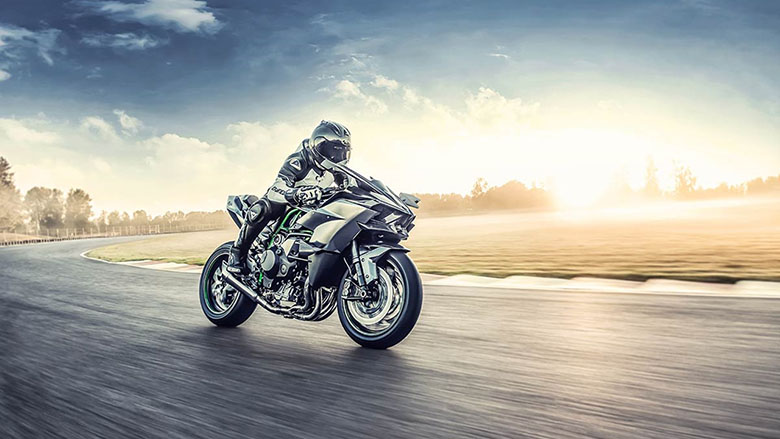
Because it’s only for use on limited courses, the 2023 Kawasaki Ninja H2R Sports Motorcycle is a technical exercise in its purest form. The end product is the most potent, unique, brutally practical, and sophisticated motorcycle ever available. The 2023 Kawasaki Ninja H2R Sports Motorcycle will take riders on the adventure of a lifetime like no other production motorcycle can.
2023 Kawasaki Ninja H2R Sports Motorcycle – Features and Specs
State-Of-The-Art
The 2023 Kawasaki Ninja H2R Sports Motorcycle now features vital improvements that bring WorldSB Championship-proven electronics management technology from the Kawasaki Racing Team (KRT). With a small IMU, inertia with six degrees of freedom can be observed (roll rate, pitch, and acceleration along the longitudinal, transverse, and vertical axes are all measured). The ECU uses special dynamic modeling software from Kawasaki to determine the yaw rate. As a result, the rider is better equipped to adjust to various off-course riding conditions thanks to precise chassis orientation awareness.
Self-Repairing Top Coat
Its unique top coat allows certain types of stains to heal themselves, allowing the paint to maintain its best shine even after normal wear and tear.
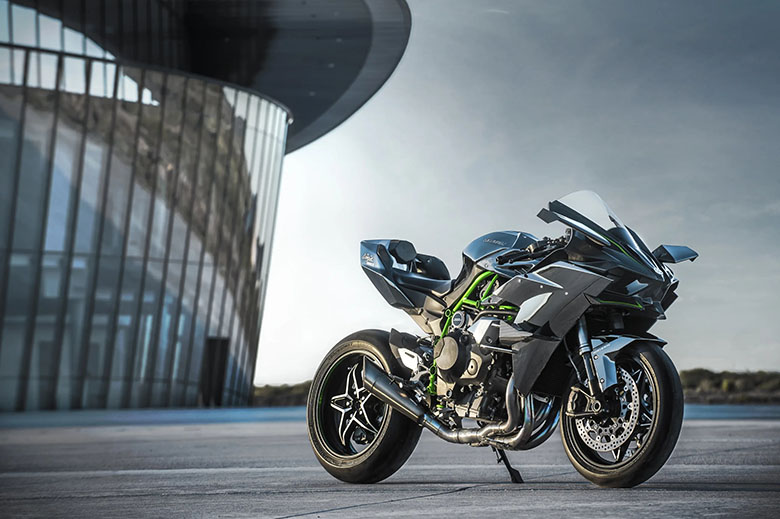
Form & Function Perfected
The 2023 Kawasaki Ninja H2R Sports Motorcycle design is a practical beauty that delivers strong power like in 2022 Kawasaki Ninja H2R. Every aspect, from the front fender to the carbon fiber wings, is meant to add unmatched performance and flair.
Engine
The 2023 Kawasaki Ninja H2R Sports Motorcycle engine needs to be small and powerful enough to accelerate at speeds that exceed or equal that of a MotoGP racer. It was determined that a supercharger was required, but any old supercharger wouldn’t do. Kawasaki’s technical departments worked together to create a supercharger that was so efficient it didn’t need an intercooler to lower the engine’s intake air temperature. An engine built to withstand 1.5–2 times the stress of a normally aspirated engine of the same size.
The crankshaft moment of inertia has been minimized and paired with a lightweight flywheel to achieve faster engine response. The relatively light rotating mass further affects high-speed handling characteristics. Dual secondary balancers ensure very low engine vibration.
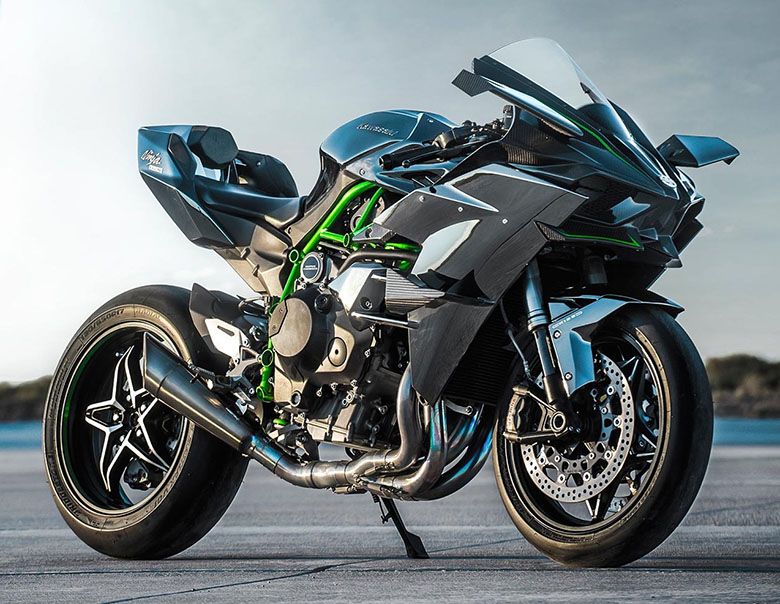
To provide strength and longevity in high-production environments, connecting rods have wide bolt diameters and massive ends to balance weight and strength. When exposed to the extremely high temperatures generated by an engine, cast pistons are more robust than forged ones. The hollow parts are manufactured using a unique casting technique, which enables maximum thickness while reducing weight. Less blow-by and oil consumption is achieved by lapping the top ring with a V-groove on the second ring land of the piston.
Each cylinder has two oil jets. To help with piston cooling. While the second nozzle concentrates its spray on the exhaust side of the bottom of the dome, the first nozzle covers the entire bottom of the piston dome. A deep sump large oil pan helps cool the oil. To avoid cavitation, the oil pan design ensures that there is always oil around the pump.
Each cylinder has two oil jets to help cool the pistons. While the second nozzle concentrates its spray on the exhaust side of the bottom of the dome, the first nozzle covers the entire bottom of the piston dome. A deep sump large oil pan helps cool the oil. To avoid cavitation, the oil pan design ensures that there is always oil around the pump.
Additionally, the oil filter’s specific angular shape and placement help prevent cavitation during sudden acceleration and deceleration. A high-flow oil pump has a high flow rate to help cool the oil while providing optimal engine and transmission lubrication. The Gas Turbine and Machinery Company at Kawasaki used a flat piston crown and combustion chamber design to prevent knocking.
A one-piece cylinder/upper crankcase uses a dummy cylinder head to obtain more accurate cylinder dimensions during the honing process. It enables low-tension piston rings, which reduces mechanical damage and improves engine response. Because chamber volume is precisely controlled, a machined combustion chamber produces high power and prevents engine knock.
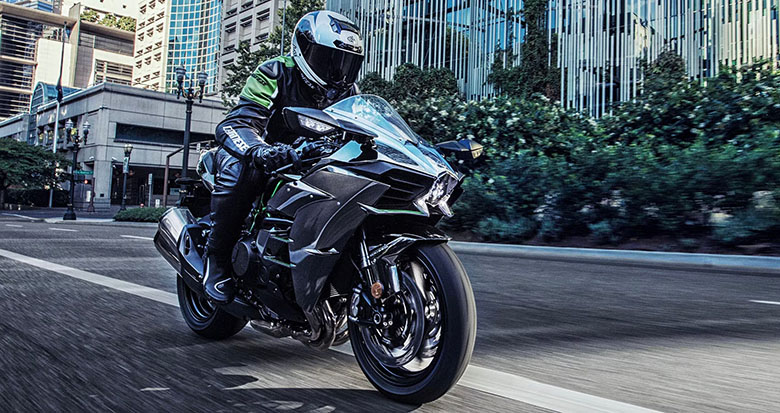
For optimum cooling efficiency, the cylinder head features a large coolant outlet, wide cooling channels around the spark plug holes and valve seats, and a water jacket between the exhaust ports of each cylinder. Broad valve overlap timing and high-lift camshafts contribute to improved performance. The highly heat-resistant compound Inconel is used to make the exhaust valve heads, and the taper stems of the valves are also heat-resistant. Intake valves are made of stainless steel.
Digital Fuel Injection
The exact operation of the 50 mm throttle valves contributes to smooth engine response. Additionally, the system supports the Kawasaki Engine Brake Control and Launch Control features and optimizes the input to the S-KTRC. A high-pressure fuel pump is used to optimize the supercharger’s high output. The exact operation of the 50 mm throttle valves contributes to smooth engine response.
Additionally, the system supports the Kawasaki Engine Brake Control and Launch Control features and optimizes the input to the S-KTRC. A high-pressure fuel pump is used to optimize the supercharger’s high output.
Kawasaki Cornering Management Function
The corner management function suppresses the bike’s tilt when braking in turn, allowing racers to follow their chosen line through a corner on the track with both KIBS and KTRC. Based on the bike’s lean and pitch angles, the IMU helps the system maintain ideal hydraulic pressure.
Kawasaki Launch Control Mode (KLCM)
KLCM electronically regulates engine output to help reduce wheelspin and limit front-end lift when starting from a standstill. It is designed to assist the rider by maximizing acceleration from a standstill. Three modes are available to riders, each offering increased intervention. With full-throttle work, the rider can launch from a stop in each mode.
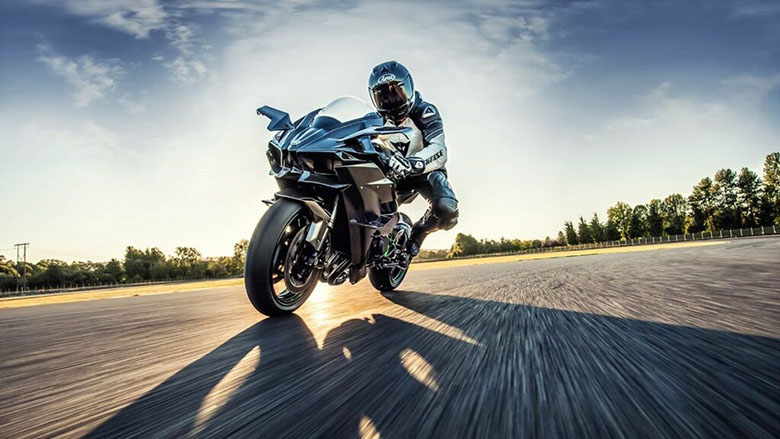
Kawasaki Traction Control (KTRC)
Multi-level modes give riders more options, with multiple levels of intervention to accommodate individual riding styles and riding conditions. All modes are designed to control the output in the event of an unexpected slip. Three modes are available to riders, each offering increased intervention. Nine different settings are available, with three additional rider-selectable levels adding varying degrees of intervention to each option. Riders can also disable the system.
While the Mode 3 settings were targeted for more slippery conditions, Modes 1 and 2 are designed for circuit riding. Three sub-settings are available for each mode, allowing you to fine-tune for different riding conditions. The system monitors traction conditions through sophisticated analysis. Low power dips allow ultra-smooth operation by intervening before slipping out of range for maximum traction.
Kawasaki Engine Brake Control
With the Kawasaki Engine Brake Control system, riders can choose their level of engine braking. When Kawasaki Engine Brake Control is turned on, the engine braking effect is reduced (by selecting “Light” in the settings).
Suspension
With the Uni-Trak linkage rear suspension system, more minor bumps receive lighter damping, and bigger bumps receive heavier damping, resulting in a smoother ride with better steering and handling. This progressive action applies to the KYB’s rear shock. The 2023 Kawasaki Ninja H2R Sports Motorcycle uses only one swing arm. It is made of lightweight, ultra-tough aluminum components that are forged and pressed.
The chassis design must be strong enough to handle the enormous power of the engine and flexible enough to withstand the bumps outside at high speeds. It also required a shorter wheelbase to keep performance and handling crisp. Ultimately, with such high output, the chassis must help dissipate the heat generated by the powertrain.
The trellis structure is constructed of high-tensile steel, and each piece’s bend, thickness, and pipe diameter are carefully selected to provide the appropriate amount of stiffness for that particular section. The ideal stiffness balance makes a fast-track ride possible and allows the structure to absorb external disturbances for increased stability.
The slim frame design and horizontal placement of the die-cast aluminum rear subframe maintain the narrow seat, which also makes it easier for the rider’s legs to reach the ground. The frame’s open design allows air trails to pass through it to help dissipate engine heat. The swingarm mounting plate is bolted to the back of the engine and integrated into the frame.
It allows the chain tension generated by the high-output engine to be efficiently transferred to the robust engine block and removes the frame cross members, helping to keep the frame light. Gas pressure is about half that of a standard shock because the shock structure prevents cavitation, allowing low-tension seals to be used for smoother shock action and less friction.
The adjusters for compression and rebound damping can be separated thanks to channels connecting the compression and rebound valves to the respective sides of the main piston. Since adjusting one damping setting won’t affect the other, it helps with suspension setup. Adjustable by hand or with an Allen key, the premium machined finish TTX GP-style adjuster knobs provide 22-way adjustment for both compression and rebound damping. Remote hand-turn preload adjustment is easy to set up and requires no tools.
Öhlins Shock
Equipped with an Öhlins TTX36 shock with remote preload adjustment, TTX GP-style damping controls, and a machined cylinder body. The shock absorbs vibration from the track well, contributes to a planted front-end sensation, is flexible for a comfortable ride and dynamic handling, and improves cornering performance.
The revolutionary shock features a solid core piston that only moves oil in the shock cylinder and a unique concentric twin-tube design. All the parts that produce damping are located at the top of the shock cylinder between the reservoir and the cylinder head. The basic design guarantees consistent damping performance, avoids cavitation and makes shock components lighter and more compact.
Aerodynamics
Upper cowl winglets incorporate strake and dogtooth extensions to create vortices that help suppress front lift at high track speeds, increase downforce if the front does lift, and help guide wind away from the rider—cockpit riding position designed to maximize speed on a circuit. There are fewer forward-lean, slightly broader handlebars, and 10mm more front-positioned footpegs than on the Ninja ZX-10R.
The solo seat is wider in the back for comfort and support of the rider and tapered in the front to make it easier to touch the ground. Adjustable side hip supports on the compact rear cowl help brace the rider during hard acceleration. It has a sophisticated, entirely digital meter design with an analog tachometer with illuminated rpm digits that follow the movement of the tachometer needle.
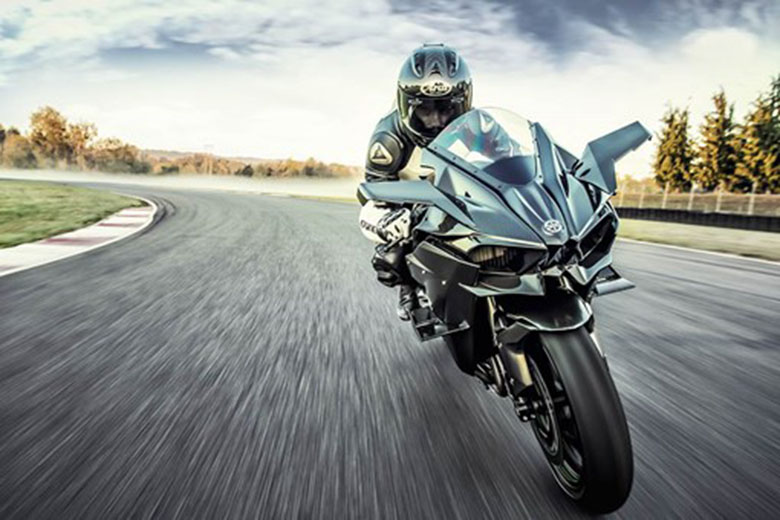
2023 Kawasaki Ninja H2R Sports Motorcycle – Price
The new 2023 Kawasaki Ninja H2R Sports Motorcycle is available for $57,500 only.
2023 Kawasaki Ninja H2R Sports Motorcycle – Technical Specifications
Engine
| Engine type | Liquid-cooled, 4-stroke InlineInline Four with Supercharger |
| Displacement | 998 cm³ |
| Bore x stroke | 76 x 55 mm |
| Compression ratio | 8.3:1 |
| Valve system | DOHC, 16 valves |
| Fuel system | Fuel injection: Ø 50 mm x 4 with dual injection |
| Ignition | Digital |
| Starting System | Electric |
| Lubrication | Forced lubrication, wet sump with oil cooler |
Gear Performance & Transmission
| Maximum power | 228 kW {310 PS} / 14,000 rpm |
| Maximum power with RAM air | 240 kW {326 PS} / 14,000 rpm |
| Maximum torque | 165 N•m {16.8 kgf•m} / 12,500 rpm |
| Transmission | 6-speed, dog-ring |
| Final drive | Sealed chain |
| Primary Reduction Ratio | 1.551 (76/49) |
| Gear Ratios 1st | 3.188 (51/16) |
| Gear Ratios 2nd | 2.526 (48/19) |
| Gear Ratios 3rd | 2.045 (45/22) |
| Gear Ratios 4th | 1.727 (38/22) |
| Gear Ratios 5th | 1.524 (32/21) |
| Gear Ratios 6th | 1.348 (31/23) |
| Final reduction ratio | 2.333 (42/18) |
| Clutch | Wet multi-disc, manual |
Suspensions Brakes & Suspension
| Brakes, front | Dual semi-floating 330 mm Brembo discs. Caliper: Dual radial-mount, Brembo Stylema monobloc, opposed 4-piston |
| Brakes, rear | Single 250 mm disc. Caliper: Brembo, opposed 2-piston |
| Suspension, front | 43 mm inverted fork with rebound and compression damping, spring preload adjustability, and top-out springs |
| Suspension, rear | New Uni-Trak, Öhlins TTX36 gas-charged shock with piggyback reservoir, compression damping, rebound damping, preload adjustability, and top-out spring |
Dimensions Frame & Dimensions
| Frame type | Trellis, high-tensile steel with Swingarm Mounting Plate |
| Trail | 108 mm |
| Wheel travel front | 120 mm |
| Wheel travel rear | 135 mm |
| Tyre, front | 120/600 R17 |
| Tyre, rear | 190/650 R17 |
| Steering angle, left/right | 27° / 27° |
| L x W x H | 2,070 x 850 x 1,160 mm |
| Wheelbase | 1,450 mm |
| Ground clearance | 130 mm |
| Fuel capacity | 17 litres |
| Seat height | 830 mm |
| Curb mass | 216 kg |

